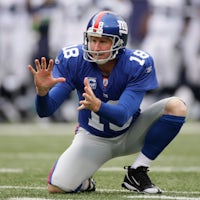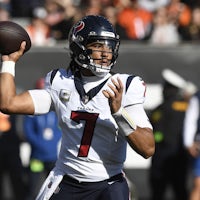NFL Week 13 Parlay: Best bets for Thanksgiving Weekend
After hitting the third parlay over the last six weeks in Week 12, YouBet.com is back to recommend the following NFL Week 13 parlay.
YouBet
Missouri sports for winning bets, launching on December 1st
Missouri residents, here is what you can bet on DAY 1 of legal sports betting!
YouBet
NFL Week 12 Parlay: Ravens working back into playoff picture
YouBet.com has studied the Week 12 NFL action and recommends the following parlay for three best wagers.
YouBet
NFL Week 11 Parlay: Bears bring two-game win streak to Vikings
After scouring the Week 12 slate, YouBet.com is excited to recommend the following three best bets in an NFL Week 12 parlay.
YouBet
NFL Week 10 Parlay: Packers seek to bounce back in pivotal NFC matchup
YouBet.com has a parlay wager for Week 9 of the 2025 NFL season consisting of three best bets.
YouBet
NFL Week 9 Parlay: Colts face difficult road test, Seahawks return off bye
YouBet.com has studied the Week 9 NFL slate and will parlay our three best bets into a Week 9 parlay.
YouBet
ADVERTISEMENT
NFL Week 8 Parlay: Important home tests for Eagles, Ravens
After analyzing the betting board, YouBet.com will look to stay hot with the following Week 8 NFL parlay.
Picks
NFL Week 7 Parlay: Jaxson Dart and Giants travel to Mile High
YouBet.com scours the NFL slate each week for a three-team parlay and will recommend the following parlay for Week 7.
YouBet
NFL Week 6 Parlay: Jags host road-savvy Seahawks on short rest
After hitting its Week 5 parlay, YouBet is back to provide a parlay pick for Week 6 of the 2025 NFL regular season.
YouBet
NFL Week 5 Parlay: Rookie road test for Giants, Eagles face defensive stalwart
YouBet.com has scoured the slate and selected the following parlay in Week 5 of the 2025 NFL regular season.
YouBet
Week 4 NFL Parlay Play: Commanders buoyed by strong defense in Daniels’ absence
Week 4 of the NFL regular season features plenty of intriguing games, and YouBet has selected three wagers for a parlay pick below.
YouBet
Odds to Win NFC West in NFL 2025-26 Season
Explore the latest odds to win the NFC West, with insights on division trends, betting shifts, and key factors shaping the race this season.
NFL
Odds to Win NFC North in NFL 2025/2026 Season
Explore the latest odds to win the NFC North, with insights on division trends, betting shifts, and key factors shaping the race this season.
NFL
Odds to Win NFC East in NFL 2025-26 Season
Explore the latest odds to win the NFC East, with insights on division trends, betting shifts, and key factors shaping the race this season.
NFL
NFL Week 3 Parlay: Early-season showdown between heated NFC West rivals
After a thorough review of the NFL Week 3 slate, YouBet.com offers its best parlay bet.
YouBet
NFL Week 2 Best Bets: Bills travel to Jets following dramatic comeback win
After an opening week punctuated by dramatic comeback wins, Week 2 of the 2025 NFL season promises to be exciting, and YouBet.com provides best bet selections!
YouBet
Top 5 Bet Types for Beginner NFL Bettors
New to NFL betting? Discover the top 5 bet types every beginner should know, with simple tips to start wagering smarter in 2025.
YouBet
Over/Under Football Betting Explained: 2025 Guide to Betting Totals
Over/Under football betting explained in our 2025 guide. Learn how totals work, key strategies, and tips to bet smarter this season.
YouBet
NFL Underdog Betting Strategy: How to Profit Against Favorites
Master NFL underdog betting strategy with tips to profit against favorites, spot value lines, and win more this 2025 season.
YouBet
Best NFL Handicappers to Watch in 2025
Discover the best NFL handicappers to watch in 2025, featuring expert picks, betting insights, and strategies for the new season.
YouBet
How to Handicap NFL Games: Step-by-Step Guide for 2025
Learn how to handicap NFL games with expert strategies, key stats, and betting tips to make smarter picks this football season.
YouBet
NFL Week 1 Best Bets: NFC North Showdown in the spotlight
Unofficially known as the best time of the year, the 2025 NFL regular season is finally upon us! And we’re excited to promote the action at YouBet.com.
YouBet
Best NFL Futures Bets to Make for 2025-26
Uncover the best NFL futures bets for the 2025-26 season with expert picks, odds insights, and winning betting strategies.
Picks
Illinois NFL Betting Guide: Legal Sportsbooks, Bonuses & More
Explore Illinois NFL betting with our guide to legal sportsbooks, top bonuses, betting lines, and expert tips for the 2025 season.
NFL
Colorado NFL Betting Guide: Legal Sportsbooks, Bonuses & More
Explore Colorado NFL betting with our guide to legal sportsbooks, top bonuses, betting lines, and expert tips for the 2025 season.
NFL
NFL Parlay Betting Strategies for the 2025-26 Season
Master NFL parlay betting in 2025-26 with smart strategies, expert tips, and ways to boost your odds all season long.
NFL
Top NFL Betting Strategies for Your Best Football Season
Discover top NFL betting strategies to improve your wins. Learn key tips, line analysis, and smart football betting approaches on YouBet.
NFL
NFL Betting Promos: Best Football Betting Bonuses and Offers for 2025
Discover the best NFL betting promos and football bonuses for 2025. Compare top sportsbook offers, claim deals, and start betting with YouBet.
YouBet
Best NFL Betting Sites & Sportsbooks for the 2025-26 Season
Explore top NFL betting sites for the 2025-26 season. Compare platforms, unlock exclusive offers, and find the best options for football wagering on YouBet.
NFL
Best NFL Betting Apps for Safe & Legal Mobile Wagering
Find the best NFL betting apps for safe and legal mobile wagering. Compare top platforms, bonuses, and features to bet confidently with YouBet.
NFL
NFL Preseason Betting Guide: How to Bet on the NFL Preseason
Learn how to bet on the NFL preseason with expert strategies, betting lines, and tips. Explore odds, picks, and insights in the complete guide on YouBet.
NFL
How to Bet on NFL Player Props in 2025-26 Season
Learn how to bet on NFL player props in the 2025-26 season with expert tips, betting markets, and strategies to maximize value.
YouBet
Where Can I Bet on NFL Games Legally? States, Rules & Bonuses
Discover where you can legally bet on NFL games with our guide to states, rules, top sportsbooks, and bonuses for 2025.
YouBet
Michigan NFL Betting Guide: Legal Sportsbooks, Bonuses & More
Explore Michigan NFL betting with our guide to legal sportsbooks, top bonuses, betting lines, and expert tips for the 2025 season.
YouBet
Tennessee NFL Betting Guide: Legal Sportsbooks, Bonuses & More
Explore Tennessee NFL betting with our guide to legal sportsbooks, top bonuses, betting lines, and expert tips for the 2025 season.
YouBet
Ohio NFL Betting Guide: Legal Sportsbooks, Bonuses & More
Explore Ohio NFL betting with our guide to legal sportsbooks, top bonuses, betting lines, and expert tips for the 2025 season.
YouBet
Indiana NFL Betting Guide: Legal Sportsbooks, Bonuses & More
Explore Indiana NFL betting with our guide to legal sportsbooks, top bonuses, betting lines, and expert tips for the 2025 season.
YouBet
2025 NFL Coach of the Year Odds: Value Picks for the New Season
Who is leading the 2025 NFL Coach Of The Year odds? Check what the best value picks are for the new season here.
NFL
NFL Prop Bets: Player Milestones and Records to Watch (2025-26)
NFL prop bets for the 2025 season are already here. Check what the best player milestones, records to bet on, and much more.
NFL
NFL International Games 2025: Full Schedule and How to Bet
Explore the NFL International Games 2025 full schedule, matchups, venues, and expert betting tips to make the most of this year’s overseas action.
NFL
NFL Power Rankings 2025: Preseason Rankings for All 32 Teams
Check out the NFL Power Rankings 2025 preseason list with all 32 teams ranked, key insights, and early-season outlooks before kickoff.
NFL
NFL Over/Under Wins: Best Team Totals to Bet Now (2025)
What are the best team totals to bet now? Check out the odds for the best teams to bet on the NFL Over/Under Wins 2025 season.
NFL
FanDuel Casino Bonus Code Michigan: Bet $5 Get $150 in Bonus Bets
If you’re a Michigan player and want to get in on the action, let’s start with a FanDuel Casino Michigan bonus code to see if you can get your hands on the operator’s fantastic welcome bonus for new players.
YouBet
Same Game Parlay Strategy: Best SGP Betting Strategies
Let's examine the same-game parlay (SGP) bet, which combines several wagers from one fixture, be it in the NHL, NFL, or MLB.
YouBet
How to Bet on Futures on Super Bowl LX
Learn how to bet futures on Super Bowl LX ahead of the 2026 showdown. Understand what futures betting is, how it works, and how to find value.
Picks
Best Super Bowl Betting Sites, Promotions & Bonuses for 2025
Super Bowl Sunday is nearly here, and you know what that means. The very best Super Bowl betting promos have arrived, and sports bettors can win big on the big game. Each online sportsbook has stepped up their game for the big game, offering Super Bowl promos that will bolster your bankroll.
YouBet
Super Bowl Betting Tips, Strategies & Winning Tactics (2025)
If you have been considering making a Super Bowl parlay, wagering on the Super Bowl MVP, playing the point spread, or just picking the winning team, there is a lot of ground to cover. Here is what to know before you start betting on all the action the Super Bowl has to offer.
YouBet
Big Game Preview Show: Super Bowl Sunday Betting Strategy [VIDEO]
Get ready for the Big Game! Our NFL experts, Ashley Anderson and James Scully, break down the highly anticipated Super Bowl LVII matchup.
YouBet
Boost the Bankroll: NFL Five-Team Teaser Play for Week 18 of 2025
YouBet will preview the big game between the Lions and Vikings in its Best Bets for Week 18 of the 2024 NFL regular season
Picks
The worst teams in NFL history
Join us as we examine 10 historically awful cellar dwellers whose feeble feats live on in infamy.
YouBet
Ranking the greatest Detroit Lions of all time
Though they’ve never won a Super Bowl, the Detroit Lions have had many Hall of Famers pass through their locker room over the years.
NFL
NFL: The greatest plays in Brett Favre's career
In honor of No. 4, let’s look back on some of his other memorable moments, as we rank the five best plays of Favre's career.
NFL
Five NFL teammates who absolutely despised each other
Just because players suit up for the same team doesn’t mean they have to like each other. On the contrary, there have been plenty of times in NFL history where stars haven’t gotten along.
NFL
Quarterback Jared Goff's record against every NFL team
Let's look back at new Detroit Lions quarterback Jared Goff's journey in the league, as we break down his regular-season and postseason records against every NFL team.
NFL
The scariest players in NFL history
There’s no doubting the toughness of any NFL player, but there have been some titans of the turf who appeared to be a different breed. With Halloween just around the corner, we decided to rank the five scariest players in NFL history.
NFL
Top 10 players with the most receiving yards in NFL history
From Reggie Wayne to Jerry Rice, these are the 10 most prolific pass-catchers in NFL history.
NFL
Top 10 oldest players in NFL history
The average NFL career only lasts 3.5 years, but there was nothing average about these nine players, who played well into their 40s.
NFL
Ben Roethlisberger's record against every NFL team
Let’s examine Pittsburgh Steelers QB Ben Roethlisberger's career by looking at his record against every NFL team in the regular season and postseason.
YouBet
Drew Brees' record against every NFL team
Let’s look back at Drew Brees' overall record against every NFL franchise and break down a few fun facts related to some of the Saints quarterback's most noteworthy matchups.
YouBet
The best backfields in NFL history
Let’s focus in on the game as it’s currently played in the modern era of the league and rank the five best backfields in NFL history.
NFL
Top 10 defensive backs in NFL history
Here are the 10 best players to ever play in the defensive backfield in NFL history.
NFL
The five oldest quarterbacks to win a Super Bowl
Tom Brady tops the list, with his last title coming at the age of 41. On Sunday, he has the chance to break his own record.
NFL
10 NFL players with the longest careers
With a new season around the corner, let's tip our cap to the 10 players with the longest careers in NFL history.
NFL
The most gruesome injuries in NFL history
There have been some absolutely gruesome injuries in the history of the NFL. Some were simply football plays, while a few of them were quite freak accidents. Join us as we rank the 10 worst injuries to happen during an NFL game.
Injury Reports
Top 10 NFL cornerbacks of all time
Cornerbacks are some of the most critical defenders on the field, particularly in the NFL’s modern era. Here, we rank the top 10 cornerbacks in NFL history and discuss their long-lasting impact.
YouBet
Most Field Goals Made in a Game Throughout NFL History
Below YouBet outlines the list of players who have made the most field goals in a game throughout NFL history, with the late Rob Bironas sitting atop the group for nearly two decades now.
YouBet
The Most Popular NFL Teams by State: The Ultimate List
Below YouBet gives you a look at the most popular NFL team in each state of the U.S.
YouBet
5 slowest 40-yard dash times in NFL history
Below YouBet looks at the five slowest 40-yard dash times in NFL combine history.
YouBet
Using negative stats to your advantage when betting the NFL
When it comes to the NFL, just about everything is tracked. It's easy to get lost in the statistics, trying to determine which have value relative to the spread and which don't. Here are five key statistics that tell me I don't want to wager on a tea ...
NFL
Five important stats to lean on for NFL wagering
While some NFL stats show up like a big red flag before you decide to place a wager, others appear as a green light prompting you to fire away . Let's take a look at five key stats that indicate one team is in a better position than its opponent.
NFL
Brett Favre Super Bowl Wins, Years, Teams, Scores, Stats, and More
Below YouBet explores the iconic career of Favre, as we look at his previous Super Bowl wins, appearances, stats, and accolades.
YouBet
Atlanta Falcons Super Bowl Wins, History, Appearances, and More
YouBet details the Atlanta Falcons' past Super Bowl appearances over the franchise's 58-year history.
YouBet
New York Jets Super Bowl Wins, History, Appearances, and More
YouBet goes back in time to look at the New York Jets’ past Super Bowl wins and appearances in the franchise’s 64-year history.
YouBet
Russell Wilson Super Bowl Wins, Years, Teams, Scores, Stats, and More
Below YouBet reflects back on Wilson's career, as we look at his previous Super Bowl wins, appearances, stats, and accolades.
YouBet
Aaron Rodgers Super Bowl Wins, Years, Teams, Scores, Stats, and More
Below YouBet dives further into Aaron Rodgers’ career, as we look at his previous Super Bowl wins, appearances, stats, and accolades.
YouBet
Chicago Bears Super Bowl Wins, History, Appearances, and More
Below YouBet takes a closer look at each of Chicago's Super Bowl appearances and wins over the franchise's 103-year history.
YouBet
Cincinnati Bengals Super Bowl Wins, History, Appearances, and More
The Cincinnati Bengals have made three Super Bowl appearances, but the organization still seeks its first Vince Lombardi Trophy, one of 12 teams to never win the Super Bowl.
YouBet
Which states have multiple NFL teams?
With 32 franchises in the National Football League, more than half of the U.S. states could house an NFL team, but only 22 currently hold that distinction.
YouBet
How Much Do Super Bowl Players Get Paid If They Win?
The winner of Super Bowl LVIII has a lot more than the Lombardi Trophy coming home with them. Per the NFL’s collective bargaining agreement, players on the winning Super Bowl team at the end of the 2023 season each receive a $164,000 bonus, and that’s on top of a whole lot of cash they get for each round of the NFL playoffs.
NFL
Patrick Mahomes' Super Bowl Wins, Years, Teams, Scores, Stats, and More
Ahead of Super Bowl LVIII, YouBet does a deep dive into Mahomes' past Super Bowl appearances, including his pair of victories, past opponents, stat lines, and more.
NFL
Kansas City Chiefs Super Bowl Wins, History, Appearances, and More
Below YouBet takes a closer look at each of Kansas City's super bowl appearances and wins over the franchise's 64-year history.
NFL
The Taylor Swift effect: Chiefs, Travis Kelce Over/Unders with popstar in attendance
Below we do a week-by-week breakdown of the Chiefs' 2023 season with a look into the team's win/loss record, their against-the-spread (ATS) record with Swift in attendance, and Kelce's Over/Under on receiving yards with and without his better half in attendance.
NFL
Jordan Love's record against every NFL team
Below YouBet does a deep dive into Love's early career and explores his regular-season record against every NFL team.
NFL
Jalen Hurts' record against every NFL team
Below we explore the highlights of Hurts' early career and look at this regular-season and postseason records against every NFL team.
NFL
Trevor Lawrence's record against every NFL team
YouBet takes a look at Lawrence's budding career and examine his regular-season and postseason records against every NFL team.
NFL
C.J. Stroud's record against every NFL team
A Heisman Trophy finalist in 2021 and 2022 as the leader of the Ohio State Buckeyes offense, C.J. Stroud landed at the Houston Texans as the second overall pick of the 2023 NFL draft and has far exceeded expectations as a rookie.
NFL
Brock Purdy's record against every NFL team
"Mr. Irrelevant" of the 2022 NFL Draft, Brock Purdy, was anything but during his rookie campaign for the San Francisco 49ers.
NFL
Tua Tagovailoa's record against every NFL team
With a current 27-15 record as a starter, let's look back on Tagovailoa's young career as we break down his regular-season record against every NFL franchise and highlight some of his top performances.
NFL
The worst Super Bowl halftime shows of all time
From the uninspired to the downright lazy, here are the five worst Super Bowl performances of all time.
NFL
How to bet on the Super Bowl
The Super Bowl is not only the most watched television broadcast in the U.S. It’s also the largest betting event in America. To get you ready for the NFL championship, here is everything you need to know about betting on football, particularly on Super Bowl Sunday.
NFL
Top 5 Super Bowl halftime shows of all time
The Super Bowl halftime show has long bridged the gap between the hardcore football junkie and casual observer of the big game. While many tune in for the action-packed battle on the gridiron, some find the performance between halves the most alluring part of Super Bowl Sunday.
NFL
The best Super Bowl commercials of all time
Join us as we count down the five best Super Bowl commercials of all time.
NFL
The biggest blowouts in Super Bowl history
Most casual fans tune in to the Super Bowl hoping for a compelling, down-to-the-wire game. The closer the score and the more nail-biting moments, the better. But every now and then, one team blows the doors off the opposition.
NFL
How to throw the best Super Bowl party
For those planning to host a party for the occasion, TwinSpires Sports has you covered on what to cook, how to decorate, and most importantly, how to bet on Super Bowl LVI.
NFL
The greatest upsets in Super Bowl history
Favorites beware! The underdog finds a way to win the Super Bowl nearly a third of the time. But not all upsets are created equal. Usually one team is a small favorite, but on a few occasions, we have seen underdogs rise up and slay colossal favorites. Here is a list of the greatest shockers in Super Bowl history.
NFL
Tom Brady's record against every NFL team
We've compiled Tom Brady’s regular-season and postseason records against each NFL franchise, plus a few fun facts related to some of his most memorable matchups.
NFL
The biggest collapses in Super Bowl history
They almost had it all. There is no worse time for an NFL team to lose its composure than the Super Bowl, and these five teams found a way to snatch defeat from the hands of victory. Let’s take a look at the most devastating collapses in Super Bowl history.
NFL
The greatest plays in Super Bowl history
As we prepare for Super Bowl LVI, we count down the five most memorable moments and spectacular plays in Super Bowl history.
NFL
POPULAR ARTICLES
Missouri sports for winning bets, launching on December 1stNFL Week 12 Parlay: Ravens working back into playoff pictureNFL Week 11 Parlay: Bears bring two-game win streak to VikingsNFL Week 10 Parlay: Packers seek to bounce back in pivotal NFC matchupNFL Week 9 Parlay: Colts face difficult road test, Seahawks return off bye
ADVERTISEMENT






















































































